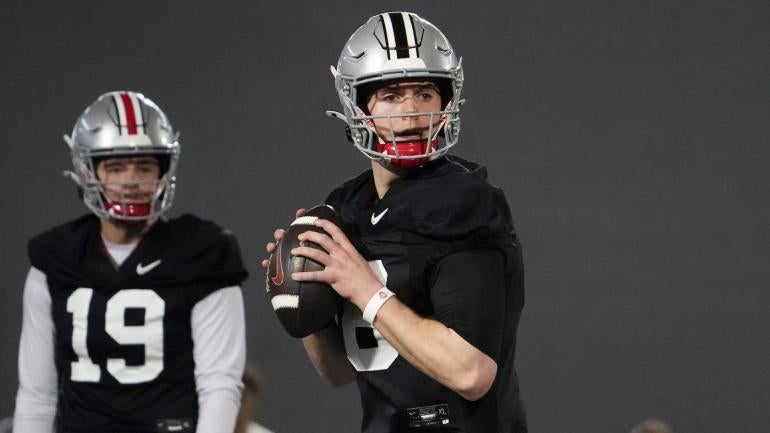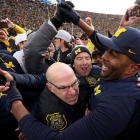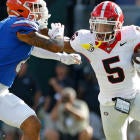
When Ohio State takes the field for its spring game on Saturday, the college football world will get its first glimpse at the changes made by the Buckeyes over the offseason. Chip Kelly gave up a head coaching job to become offensive coordinator in Columbus. Ryan Day and his staff were very active in the transfer portal, bringing in more talent to add to what already a loaded depth chart. Wide receiver Jeremiah Smith, the No. 1 recruit in the nation who is already raising eyebrows with highlight catches in practice, will get the chance to show everybody why he was rated so highly.
While all that is interesting, the focal point of Saturday's scrimmage should what Will Howard -- who transferred from Kansas State to replace Kyle McCord, who's now at Syracuse -- brings to the table at quarterback. Landing Howard out of the portal was among the most interesting moves by a national title contender this offseason.
Is Howard, who may have been on the verge of losing his starting gig to Avery Johnson at Kansas State, a clear upgrade over McCord? Well, that depends on what you're looking to upgrade. When it comes to being a traditional QB and distributor of the football, I'd argue not. Howard is a more mobile QB who should fit better in Kelly's offense than McCord would have, and that alone could mean he's a solution to Ohio State's biggest problem on offense last season.
Ohio State could not finish drives last season. Here's a look at how the Buckeyes fared in the red zone compared to the four College Football Playoff teams and Georgia in the regular season.
| Team | Red Zone Drive Rate | RZ TD Rate | Points per RZ Poss. | Success Rate in RZ |
|---|---|---|---|---|
Ohio State | 34.72% | 64.0% | 4.50 | 44.7% |
31.14% | 69.2% | 4.85 | 50.0% | |
| Georgia | 52.6% | 69.1% | 4.81 | 48.3% |
| Michigan | 40.00% | 71.2% | 4.82 | 54.0% |
| Texas | 36.97% | 50.8% | 3.93 | 41.3% |
| Washington | 41.95% | 67.1% | 4.60 | 53.0% |
Compared to the rest of the elite, Ohio State lags in the red zone against everybody not named Texas. As for how Texas managed to reach the College Football Playoff while being so uninspiring in the red zone, Quinn Ewers can hit deep shots, and while they won't want to hear it, playing in the Big 12 provided a bit more leeway for imperfections.
So, how does Howard change this? Probably not a whole lot as a passer, though considering how strong Ohio State's receiving corps is compared to Kansas State's, his numbers are likely to improve. Compared to McCord's last season, however, the difference wasn't stark.
| In red zone | Pass. Efficiency | Comp. Rate | TD Rate | Yards Per Dropback |
|---|---|---|---|---|
Kyle McCord | 179.8 | 42.1% | 31.6% | 4.40 |
Will Howard | 181.0 | 55.7% | 26.2% | 4.61 |
McCord didn't complete passes at the same rate as Howard, but the rate of touchdowns he threw was far greater, balancing the efficiency metrics. We really see the difference in how each player impacts things in the run game.
Now as a rushing threat, McCord simply doesn't compare to Howard.
| In red zone | Rushes | Rushing Yards | Rushing TD | 1st Downs |
|---|---|---|---|---|
Kyle McCord | 2 | 3 | 0 | 1 |
Will Howard | 29 | 79 | 8 | 2 |
The numbers are similar outside the red zone, too. Howard's legs are far and away the most attractive option to the Buckeyes, and it's not just for Howard's rushing output.
It's not a startling revelation to say it's harder for defenses to stop the run when the quarterback is involved. It goes from a case of 10-on-11 to 11-on-11 when defenses need to account for the QB. This gives the offense an advantage all over the field, particularly in the red zone, where the offense doesn't need to worry about breaking long runs. The slightest hesitation by a defense when deciphering who has the ball is all an offense needs to cross the goal line.
While it's not the sole reason Ohio State struggled to run the ball in the red zone last season, the fact defenses didn't have to worry about McCord was no help. The closer Ohio State got to the goal line, the worse their rushing output became as defenses sold out to stop the run while knowing where it would come from. Look at how the Buckeyes compared to the rest of the Power Five inside the 5-yard line.
| Rushing Inside the 5 | Yards per Attempt | Success Rate | EPA per Rush | TD Rate |
|---|---|---|---|---|
Ohio State | 1.2 | 52.6% | 0.01 | 36.84% |
Power 5 Average | 1.2 | 60.1% | 0.20 | 48.00% |
The numbers don't lie. The closer Ohio State's offense got to the end zone last season, the more difficult it became to score. That's a serious problem for any team, let alone one trying to compete for conference and national titles.
Howard's presence alone will not fix this. Of Ohio State's running backs last season, TreVeyon Henderson was the most successful in the red zone. He averaged 4.2 yards per carry and scored six touchdowns. Chip Trayanum and Miyan Williams weren't nearly as reliable; they combined for 2.7 yards per carry and five touchdowns on 41 red zone carries.
That's why Ohio State also grabbed Quinshon Judkins from Ole Miss in the transfer portal. Judkins had 126 red zone carries and scored 29 touchdowns during his time with the Rebels. He's a much better complement to Henderson in that part of the field than Trayanum and Williams were.
The addition of Howard and Judkins gives the Buckeyes more ways to score and will make life extremely difficult on opposing defenses. The spring game will be our first chance to see it in action, but the impact will be felt in the fall and. If Ohio State has its way, it'll be evident in January, too.

















